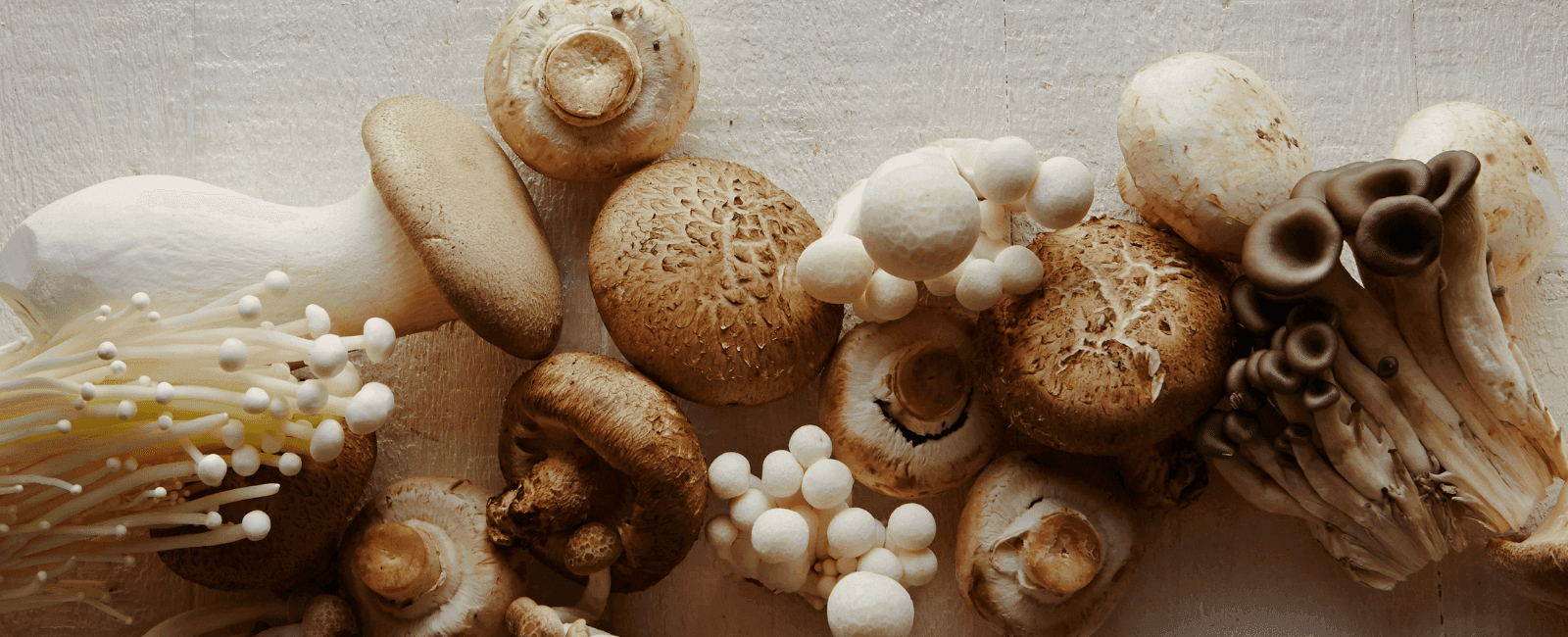

A mushroom a day keeps the doctor away. At least, that’s what we think at Shroomer! Whether you love or hate them, mushrooms are a nutritional powerhouse that can significantly benefit your health. But what are the nutritional benefits of eating mushrooms, and how can these superfoods reduce the risk of chronic illnesses? Join us as we explore the dense dietary profile of various mushrooms, their role in promoting long-term health, and practical ways to incorporate them into your daily diet to harness their full potential.
What are mushrooms?
Many people view mushrooms as some kind of vegetable since that’s how they’re used in a culinary sense. However, mushrooms actually belong to a kingdom of organisms called fungi and are distinct from plants, animals, and bacteria. Unlike plants, mushrooms do not use photosynthesis as an energy source. Instead, they absorb their nutrients by decomposing organic material around them and converting it into usable forms. As decomposers, fungi, such as mushrooms, secrete enzymes to break down complex organic compounds and turn them into simpler substances. This vital process not only sustains mushrooms but also plays a key role in nutrient cycling within ecosystems.
The unique way mushrooms absorb nutrients helps enrich their nutritional profile, which is abundant in vitamins, minerals, and antioxidants, along with several other beneficial bioactive compounds. These nutrients make mushrooms a valuable addition to a balanced diet, offering several health benefits.
Types of mushrooms

Mushrooms have all sorts of unique appearances, flavors, and textures. Their wide variety is what makes them such a popular choice in cuisines around the globe. Understanding the different types of mushrooms can enhance your cooking and help you make informed choices about their health benefits.
Common edible mushrooms:
Most grocery stores typically only sell a limited variety of mushrooms that can be cultivated at large levels at a commercial scale. Most of these varieties actually belong to the same species, Agaricus bisporus.
- White button mushrooms: These are the most consumed mushrooms globally. They are the immature form of A. bisporus and are harvested before the cap has fully opened. White mushrooms have a milder flavor and tender texture, which makes them a popular choice in several dishes.
- Cremini mushrooms: Slightly more mature than white buttons, creminis have a partially opened cap and are known for their firmer texture and richer flavor, making them suitable for heartier recipes.
- Portobello mushrooms: The fully mature form of A. bisporus, portobellos have an open, broad cap and a dense, meaty texture. They are often grilled or baked, used in sandwiches, or served as a meat alternative in various dishes.
Specialty mushrooms:
As mushrooms gain more mainstream popularity, more shops have begun selling other types of mushrooms beyond the more basic ones. If you can’t find these mushrooms in your typical store, you may have some luck locating them at a specialty Asian store or your local farmers market.
- Shiitake mushrooms (Lentinula edodes): Valued for their rich, umami flavor and meaty texture, shiitakes are a staple in many Asian dishes, adding a savory depth to soups and stir-fries. They are also known for being rich in bioactive compounds like antioxidants and polysaccharides.
- Lion’s mane mushrooms (Hericium erinaceus): With their distinctive, almost fluffy appearance, these unique-looking mushrooms are celebrated for their seafood-like taste and texture along with potential cognitive benefits.
- Enoki mushrooms(Flammulina velutipes): Characterized by their slender, elongated stems and tiny white caps, enoki mushrooms are popular in East Asian cuisine, especially in Japanese cooking. They have a mild, slightly sweet taste and a crunchy texture.
- Oyster mushrooms (Pleurotus spp.): Oyster mushrooms come in a variety of shapes and sizes. The most common oyster mushroom is white in color with a fan or oyster-shaped cap, but these fungi can also be found in shades of pink, blue, brown, and yellow. Their dense yet delicate texture and mild and sometimes seafood-like flavor make them a popular meat alternative.
- Maitake mushrooms (Grifola frondosa): Also known as “hen of the woods,” Maitake mushrooms grow in large clusters and have a ruffled appearance. They have a rich, woodsy flavor and a succulent texture, which makes them a great vegan substitute in recipes that call for chicken. Beyond their culinary uses, Maitakes are also noted for their potential health benefits, including immune system support and blood sugar regulation.
Exotic and wild mushrooms:
Some mushrooms are more challenging to cultivate commercially and are often foraged from their natural habitats. These mushrooms are highly sought after for their unique flavors and textures, and they often appear seasonally in markets or specialty stores.
- Morel Mushrooms (Morchella spp.): The iconic honeycomb-like appearance and nutty, earth flavors of morels make them one of the most sought-after wild mushrooms in the world. Since morels only grow very briefly during the spring, they are quite seasonal, making them difficult to aquire.
- Chanterelle Mushrooms (Cantharellus spp.): Chanterelles are renowned for their vibrant yellow-orange color and delicate, peppery flavor with just a hint of fruity sweetness. These mushrooms are prized for their ability to complement dishes with their subtle, yet distinct taste and can be used in everything from creamy sauces to elegant sautés.
- Porcini mushrooms (Boletus edulis): These highly valued mushrooms are popular for their robust flavor and smooth, creamy texture. Porcinis add depth to almost any dish and are a staple in Italian cuisine.
- Truffles (Tuber spp.): While truffles aren’t necessarily mushrooms, they are still one of the world’s most popular edible fungi. Their rich, pungent aroma and intense earth flavor make them a coveted ingredient in every fine dining kitchen. Since truffle harvesting is so labor-intensive, they are incredibly exclusive and come at a high cost, making them some of the most expensive fungi on the planet.
Medicinal mushrooms:
Some mushrooms have too tough of a texture or too bitter of a flavor to be considered choice edible mushrooms. Nonetheless, some fungi are still beloved due to their rich medicinal qualities. While these fungi aren’t typically incorporated into recipes, they can be steeped into a tea or taken as a supplement or tincture.
- Turkey tail (Trametes versicolor): Turkey tail mushrooms get their name from their striking, fan-shaped, colorful appearance that somewhat resembles a turkey’s tail. This fungus has been extensively researched as a potential cancer treatment because it contains a compound called polysaccharide-K (PSK), which is known to boost the immune system during chemotherapy.
- Reishi (Ganoderma lucidum): Often referred to as “the mushroom of immortality,” Reishi, or Lingzhi, has been used in Traditional Chinese Medicine (TCI) for centuries for its ability to boost immune function, reduce stress, and increase longevity.
- Chaga (Inonotus obliquus): Primarily found growing on birch trees in colder climates, Chaga is more like a dark, crusted clump than a typical mushroom. Nonetheless, this fungi proudly boasts one of the highest naturally occurring antioxidant levels in the world.
- Cordyceps (Cordyceps militarist): Don’t let Cordyceps’s unusual origin scare you off. Although the parasitic fungus grows on insect larvae, it has several proposed health benefits, such as energy enhancement, improved stamina, blood sugar management, and heart health support.
Nutritional value of mushrooms
Mushrooms are a fantastic addition to a balanced diet because of their impressive nutritional profile. Packed with essential nutrients, they contribute to a healthy diet in various ways:
Vitamins and minerals
Vitamin D: Mushrooms are among the few natural food sources of vitamin D, especially when exposed to UV light or sunlight, which enhances their vitamin D content.
Selenium: A vital mineral for human health, selenium assists with antioxidant defense systems and supports immune function.
Potassium: Crucial for maintaining normal fluid and mineral balance in the body, potassium helps control blood pressure and supports heart health.
Copper: Plays a pivotal role in red blood cell formation and iron absorption. It also helps maintain nerve cells and enhances the immune system.
Phosphorus: Helps the body synthesize proteins for cell maintenance and repair while promoting bone and teeth health.
B Vitamins: Mushrooms contain several B vitamins, which are crucial for energy metabolism and brain health.
- Riboflavin (B2): Supports skin health and aids in the breakdown of fats and drugs.
- Niacin (B3): Plays a key role in DNA repair and metabolic processes.
- Pantothenic Acid (B5): Essential for synthesizing and metabolizing proteins, carbohydrates, and fats.
- Pyridoxine (B6): Aids in protein metabolism, the creation of neurotransmitters, and the formation of red blood cells
- Folic acid (B9): Needed for the creation of DNA and other genetic material, especially during periods of rapid growth, such as pregnancy and fetal development. It’s also essential for helping the body use amino acids and form healthy red blood cells.
Antioxidants and anti-inflammatory compounds
Mushrooms also contain several compounds known for their antioxidant properties, which can reduce oxidative stress in the body and lower the risk of chronic diseases like cancer, heart disease, and neurological disorders.
- Selenium: Again noted for its role in antioxidant defense, helping to reduce oxidative stress in the body.
- Ergothioneine: Found primarily in mushrooms, ergothioneine is a naturally occurring antioxidant linked to reproductive health, skin protection, and cardiovascular health.
- Phenolic compounds: These compounds not only have antioxidant properties but also provide significant anti-inflammatory benefits.
- Glutathione: Another potent antioxidant found in mushrooms, especially maitake, porcini, and shiitake.
Immune-boosting and health-promoting compounds
Polysaccharides: Mushrooms contain several types of polysaccharides, long-chain carbohydrate molecules that serve as an energy source and enhance the immune system.
- Beta-glucans: The most well-known polysaccharide in mushrooms found in many different fungi’s cell walls. They help strengthen the immune system by activating various white blood cells like macrophages, natural killer (NT) cells, and neutrophils, all of which are vital for fighting off infections.
- Lentinan: Specifically found in shiitake mushrooms, Lentinan has been used in Japan as an adjunct cancer therapy because of its immune-boosting abilities.
- Chitin: This biopolymer makes up the cell walls of fungi and can also be found in the wings and exoskeletons of insects. Although undigestible, chitin ferments in the large intestine and acts as a fiber that supports healthy digestion.
Triterpenoids: Found in high concentrations in reishi and other species, triterpenoids offer a range of health benefits, including anti-inflammatory, antiviral, and antibacterial properties.
Lectins: These proteins bind to carbohydrate molecules and play a role in preventing microbial infections.
Health benefits of mushrooms

While different mushrooms have higher contents of certain vitamins, minerals, and bioactive compounds, all varieties share some common benefits that make them a valuable addition to a healthy diet. Each type contributes uniquely to nutritional diversity, underscoring the importance of including a variety of mushrooms in your meals.
Cardiovascular health
Mushrooms have several recognized potential cardiovascular benefits, largely due to their influence on cholesterol levels and heart health. For instance, the eritadenine and beta-glucans found in Shiitake and button mushrooms effectively reduce LDL “bad” cholesterol while potentially raising HDL “good” cholesterol. The high amounts of dietary fiber in mushrooms also help prevent cholesterol absorption in the gut, thereby improving blood lipid profiles.
Additionally, some studies have found that the triterpenes in reishi mushrooms can help prevent and treat high blood pressure by improving circulation (1). Similarly, oyster mushrooms contain peptides that inhibit an enzyme called ACE, which is responsible for regulating blood pressure.
Many mushrooms’ antioxidant and anti-inflammatory properties protect the cardiovascular system from chronic inflammation and oxidative stress, two major risk factors for heart disease. Regular consumption of mushrooms has been found to mitigate the risk of such conditions.
Digestive health
Mushrooms are an excellent source of dietary fiber, which is needed for healthy digestion, preventing constipation, and overall gut health. Plus, some of these fibers act as prebiotics and stimulate the growth of beneficial gut microbiota. These polysaccharide fibers feed good gut bacteria, ultimately supporting the stomach’s overall microbiome. Polysaccharides can also maintain the integrity of the gut barrier by regulating inflammation and influencing metabolism.
Immune system support
The high content of beta-glucans in mushrooms, particularly in varieties such as shiitake, maitake, and turkey tail, helps stimulate the immune system by enhancing the activity of immune cells. As a result, the body is able to defend itself against pathogens and potentially cancerous cells.
The antioxidants in mushrooms also play a key role in immune support and protecting the body’s cells from damage that could lead to other diseases. By combatting oxidative stress, mushrooms help maintain the immune system’s functionality.
Neurological and brain health
Several studies have found that regular mushroom consumption can help improve cognitive function and decrease the risk of mild cognitive impairment (MCI). For instance, one recent Singapore-based study found that individuals who ate more than two cups of mushrooms every week had a 50 percent reduced likelihood of developing MCI.
Lion’s mane mushrooms, in particular, have certain bioactive compounds, hericenones and erinacines, which stimulate the growth of brain cells and potentially improve cognitive function. In older populations, lion’s mane consumption has been linked to the mitigation of cognitive decline and a lower risk of developing neurodegenerative disorders like Alzheimer’s and Parkinson’s disease (2).
Metabolic and weight management
Since mushrooms are high in fiber and low in calories, they’re the perfect food for weight loss. As a result, they add volume to meals without significantly increasing the calorie intake, which can help reduce overall caloric consumption while still keeping you full. The fiber in mushrooms also helps slow digestion, leading to prolonged feelings of fullness and curbing hunger.
Additionally, mushrooms have shown promise in lowering the risk of Type 2 Diabetes because their beta-glucan content can slow down sugar absorption in the bloodstream, enhance insulin sensitivity, and reduce glycemic response for a more controlled increase of blood sugar levels after meals.
Preparing mushrooms

If you want to eat more mushrooms but don’t know where to start, fret not! There are thousands of recipes out there, and since mushrooms are versatile, they can fit just about any savory recipe.
The most common ways of cooking mushrooms are sautéing, grilling, deep-frying, and baking. Unlike many fruits and vegetables that hold more nutritional value when raw, fresh mushrooms almost always should be cooked before consumption. This is because of the tough chitin that makes up the cell walls of mushrooms. Cooking helps break down these cell walls, making the mushrooms’ nutrients more accessible to the body and easier to digest. Furthermore, some mushrooms, especially wild ones, may contain trace amounts of toxins or harmful bacteria that need to be destroyed during the cooking process. While the common edible mushrooms found in grocery stores are typically safe to eat raw, cooking them can help eliminate any residual harmful substances. Nonetheless, even though you should cook mushrooms, avoid overcooking them, as this could lead to the loss of water-soluble vitamins and beneficial compounds.
Incorporate mushrooms into your daily routine
With the many impressive health benefits they offer, it’s clear that mushrooms are a valuable addition to your diet. From stir-fries to soups, salads, and sauces, mushrooms are a fantastic way to enhance flavors while boosting nutritional content. Their umami flavor adds so much to a meal without the excess calories, making them an ideal ingredient for maintaining a healthy lifestyle. And for those who may not prefer the texture or taste of mushrooms, supplements are an excellent alternative. Full-spectrum tinctures, powders, and capsules allow you to easily incorporate medicinal mushrooms into your daily routine and provide a potent dose of their health-promoting properties.
Overall, making mushrooms a regular part of your diet or supplement regimen can be a smart and tasty strategy to boost your overall health, utilizing their unique qualities to enhance various aspects of your wellness.
References
- Chan, Sze Wa, Brian Tomlinson, Paul Chan, and Christopher Wai Kei Lam. 2021. “The Beneficial Effects of Ganoderma Lucidum on Cardiovascular and Metabolic Disease Risk.” Pharmaceutical Biology 59 (1): 1161–71. https://doi.org/10.1080/13880209.2021.1969413.
- Mori, Koichiro, Satoshi Inatomi, Kenzi Ouchi, Yoshihito Azumi, and Takashi Tuchida. 2009. “Improving Effects of the Mushroom Yamabushitake (Hericium Erinaceus) on Mild Cognitive Impairment: A Double-Blind Placebo-Controlled Clinical Trial.” Phytotherapy Research 23 (3): 367–72. https://doi.org/10.1002/ptr.2634.


